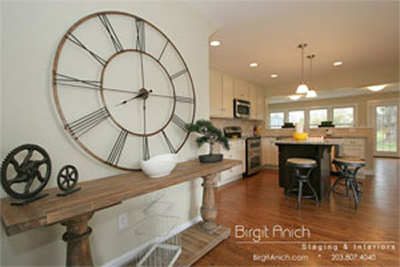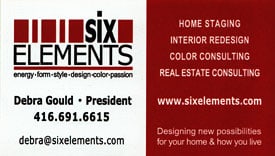
Your home staging business card is one of the most critical pieces of your home staging marketing.
Here are 9 home staging business card tips to ensure you’re creating the right image for yourself as a home stager:
1. Remember home staging is an image business.
I can usually tell which home stagers will ultimately fail almost before they start. My first clue is the quality of the logo and/or business card.
When either one is unprofessional, you are communicating that you aren’t prepared to invest in your business.
If that’s the case, don’t expect clients to invest in you either.
This sounds harsh. It’s meant to wake you up to how critical this point is because I want you to have a long and successful career as a home stager.
There’s nothing like making money doing work you love.
To enjoy this privilege for years to come, invest a minimal amount upfront to get your business image done right.
In the business card sample shown here, there was no need for a logo because of the strength of the photo. In fact a logo would have interfered with this particular design.
2. Include the address of your website.
There are many situations where someone will get your business card with no immediate opportunity to learn more about your work.
Directing them to your website gives them a chance to learn more about how you can help them, view your portfolio, etc.
Consider how often you’ve found someone’s business card stuffed in a pocket, lying under a bunch of papers, or sitting at the bottom of your purse.
How often do you forget who the card belongs to, or where you got it? The same thing will happen when you give out your own card.
You want people to feel that your business card is something worth hanging onto. And you want them to have somewhere to visit to refresh their memory about why they kept it.
Having your web address (URL) on your card is not only expected, it makes that happen.
Few home stagers have the time, money and ability to create a professional website from day one.
That’s why I created the Staging Diva Directory of Home Stagers. Within 7 days of submitting your material, you’ll have a professional page on a high traffic website.
As long as you’ve registered a domain (or URL as it’s also called), you can forward that address to your own page on the Staging Diva Directory.
That way you don’t have to build your own website now (or ever, if you don’t want to).
Many new home stagers start this way. Several Directory members have remained for many years even after they built their own site.
Donna Dazzo of New York’s Designed to Appeal (who was a Directory member for 7 years) reported that the Directory was always among the top 3 sources of visitors to her own website!
3. Consider the risks of using a photo.
Having an interior room shot, as in the business card shown above, can be very effective in communicating what a great job you do and reinforcing your image as a staging professional.
The downside is that you can really only use one image effectively on a standard-size business card, so which one will you choose?
If you go with a modern interior, you might turn off all the folks whose tastes run more to the traditional, for example.
Or if you show a home that doesn’t look like it’s in the price range of your typical customer, they might think you won’t know how to deal with a home like theirs.
Under NO circumstances should you use a stock image or a room shot that is not your work on your business card or website.
This is a common and misleading practice that can ultimately destroy your credibility. Learn why you shouldn’t use stock images (or a fake portfolio) to promote your own staging and redesign services here.
The business card example from Birgit Anich Staging & Interiors used above is a beautiful example of using a photo.
4. Include ways to get in touch with you.
![]()
At minimum you should include your name, phone number and email address.
Other options include your Twitter handle or Facebook Business Page.
With limited business card space, my preference is to leave out social media links because my first priority is to get potential staging clients to my home staging website.
From there, I provide links to find me on social networking sites.
Staging Diva Directory members can include social media icons in their listing; this is a free service with a one year commitment!
5. Decide if you want strangers showing up at your door.
One of the reasons home staging is such a great business is that you can run it from your home, eliminating the need to pay rent on an office or store front.
But, just because you are working from your home doesn’t mean you need to publish that address on your business card or anywhere else.
On my 12 (!) websites I have a physical mailing address with suite number, that’s actually a mailbox inside a UPS storefront.
It looks like a professional address, and they accept my mail and parcels.
Plus, I don’t have to worry about potential clients (or weirdos who get their hands on my business card) showing up at my door.
Personally I don’t use any physical address on my business card, I leave that detail to the contact page on my actual websites.
6. Remember not everyone knows what home staging is.
When you’re a bookkeeper, dentist or real estate agent, you don’t need to explain what you do on your business card because most everyone already has a general understanding of when/why they might hire you.
This is not always the case with home staging.
Consider a short tag line or other copy on your card to explain what you do.
Also consider whether “home staging” is the right phrase for your area. For example, in Australia, the term “property stylist” is more common.
7. Choose your business title and whether to use it.

In the business card example above, Birgit didn’t need to use a “fancy” title to communicate that she’s in charge, because her name is part of her business name.
If that’s not the case for you, consider an official title.
For example, my staging business is called Six Elements.
If I didn’t put any title on my card, no one would whether I’m an assistant or work in the accounting department!
When I hand out my card at a networking event, or when meeting a potential client or real estate agent, I want people to know they are dealing with the head of my company.
I call myself “President,” “Head Designer, ” or both depending whether it fits the design.
These titles show I’m the boss (important when you want to be taken seriously by people who care about titles), and “Head Designer” reinforces that I’m creative.
When else are you going to be president, if you don’t give yourself that title?
Personally I loathe “Business Owner” unless you own a coffee shop, dry cleaner or gas station.
I just don’t think that title is appropriate for a service business without a storefront.
That doesn’t mean I’m right, or that this advice is right for every market. You have to decide what feels comfortable to you.
8. Create something you can be proud to share.
If you are embarrassed by your business card, you won’t hand it out nearly as often as you should!
Since marketing and self promotion are part of having your own business, you don’t want to be stuck with a card that you don’t feel reflects your personality and the business image you want to project.
9. Don’t over print because it sounds cheaper.
The print quantity of our first run of business cards shouldn’t be more than 100, unless you’re preparing for a major trade show.
It takes longer to go through business cards than you imagine and you’ll want to change or update the information or design 3 or 6 months from now.
After starting various businesses and redesigning my various business cards over the past almost 30 years of being an entrepreneur, please take my word for it when I warn you about over-printing!
Since digital printing is so cheap, there really isn’t a big reason to get 500 or 1000 cards from the start. Yes, they would be cheaper per card, but I guarantee you’ll find yourself using a card you’ve long grown tired of, just because you printed too many. See point 8 above!
If you’ve found these tips helpful, imagine how much you’ll learn when you’re actually inside the Staging Diva Home Staging Business Training Program.
You’ll find all my courses include only practical, need-to-know stuff that’s based on what it’s really like being a home stager.
What’s on your business card?
I want to feature you in an upcoming post and why I love your home staging business card as I did here for Birgit Anich.
> Please post of a photo of your card on The Staging Diva Facebook wall so I can check it out.
This will give you a little extra publicity and help you meet your fellow stagers inside the Staging Diva community. Besides, aren’t you curious to see what others have created too?
Need help with your home staging business image?
The Staging Diva Ultimate Portfolio Guide: Winning clients with the perfect home staging portfolio gives you all the tips you need to create the right image for your home staging business. From how to write about yourself, get a great logo, take before and after photos, and more.
> Learn about how to create the right home staging business image so you’ll actually HAVE a staging business!
I hope you found these 9 tips to a better home staging business card helpful. Please add your comments and questions below!



Great list of idea. I especially like the idea of not printing out more cards because they claim you can save more money. If you don’t need the cards, you’re not saving money but wasting money.
I also feel like you would have to pay to include a high quality photo on your business card, it might get too crowded. Having your business card include a link to your website of photos would be a better option. Thanks for sharing!
Thanks for commenting Catherine!